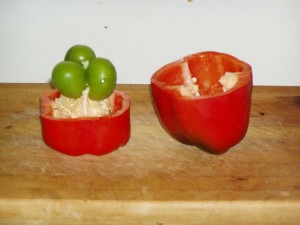Weird Plant Tricks
February 3rd, 2005
The first time I saw a “sensitive plant,” I couldn’t keep my fingers off the curious thing.
Tap this miniature member of the mimosa family (Mimosa pudica), and its little leaves fold inward. Flick it a little harder, and all the stems retract like an umbrella or like some kind of botanical turtle hiding its head.
It practically cries out to be flicked every time you walk by, and it’s a must-have plant for any kids garden.
But the sensitive plant also goes to show what kind of weird and remarkable things plants can do.
Plant geneticists are just beginning to understand the complex and clever network of genes that make plants tick.
For instance, one particular gene in roots signals the stems to grow fewer and smaller leaves when the soil moisture is getting threateningly low.
Other genes keep track of sunlight and temperature to direct plants when to bloom based on the vagaries of each season.
There’s even evidence that genes in seeds have a kind of memory that guides new growth based on the experiences of the parent plants.
Bottom line: That head of cabbage might not be as dumb as you think.
A lot of the crazy stuff that plants do revolves around survival.
The folding-up habit of the sensitive plant, for example, keeps the branches from snapping off in a windstorm and protects the leaves in hailstorms. You might even argue that it also helps procreate the species by causing easily amused gardeners to plant more of them.
Trees in particular often go to great lengths to heal and survive.
Jim Facinelli of Elizabethville marvels at the big, old sycamore he saw this past fall growing atop a field of boulders in Delaware.
“The entire tree is covering this huge pile of rocks on all sides,” he says. “I found it just amazing that a tree of this size could grow out of and surround an entire rock outcropping.”
Apparently, a seedling germinated in decayed leaf litter atop one of the rocks and then sent out roots until several of them found their way into the ground.
Facinelli also tells of a European beech growing in a church cemetery in Fisherville.
The roots and trunk have grown around the base of a nearby 19th-century tombstone so that now the stone is embedded in the tree. It’s as if the tree has become a living frame.
Much the same happened with a no-parking sign that someone installed many years ago next to a young sycamore tree in Baltimore’s Bolton Hill neighborhood.
The tree grew up and around the sign to make it look like the tree is in the process of swallowing the sign.
Lorrie Preston of Hampden Twp. found an even odder example of tree object-swallowing at the Dawes Arboretum in Newark, Ohio.
Years ago, someone wedged a long board between two oak trees. Over the years, callous tissue grew out and around the ends of the board. It now looks like a naturally secured bench — or a very fat, very low limbo stick held by oak trunks.
While hiking in Kentucky’s Daniel Boone National Forest, Preston also happened across a big, old chestnut oak tree that had a tumor-like growth nearly the size of a Volkswagen Beetle ballooning out of one side of the trunk.
The growth looked ominous, but it didn’t seem to faze the tree. A forest ranger said the bump was an unusually large “burl,” a woody growth that sometimes occurs for unknown reasons.
Doris Ranaglia came across a mutation of a different sort last summer on the blue-needled ‘Boulevard’ falsecypress in her Hershey front yard.
At the end of two different branches, flat-needled green shoots started emerging from the otherwise blue evergreen. Ranaglia said it almost appeared as if the plant started growing blue falsecypress branches and then suddenly switched over to growing green arborvitae shoots.
Penn State’s Dr. Jim Sellmer, an associate professor of ornamental horticulture, explains that the shrub “reverted” back to some of its parents’ green genes.
The ‘Boulevard’ falsecypress is actually a finer-needled, blue-tinted variation of the Japanese falsecypress, which is green and resembles arborvitae. Shoots of that original species are what began poking out of Ranaglia’s shrub, ruling out the possibility of midnight grafting by aliens.
We can’t, however, rule out alien involvement in the 20-foot tree growing out the top of a silo at a farm along Route 35 near Cross Keys, Juniata County.
Jo Ott of Lewisberry spotted this oddity while driving by one day. She stopped to ask the farmer, but he didn’t know how the tree got started there either.
“My guess is that either a wind-blown seed germinated inside the silo or was dropped by birds,” says Ott. “The farmer assured me it wasn’t planted there.”
Ott, who apparently has a keen eye for things growing where they shouldn’t, also noticed a speed-limit sign last year along Bull Road in York County that seemed to be growing a head of hair.
When she stopped for a closer look, it turned out that a vine had grown up through the hollow sign post and sprouted up and over the sign.
That’s almost as weird as the day Robert Newmyer of Wormleysburg bought a seemingly normal red pepper at Harrisburg’s Broad Street Market.
“I remember thinking as I was about to cut it up for dinner that I wished I had bought green peppers to go with the red one,” says Newmyer. “When I cut it open, I was pretty surprised to find what looked like a second green pepper growing inside the red one.”
Apparently, this pepper-in-a-pepper trick resulted from a mutation of some sort. Either that or Newmyer has a secret genie granting his wishes.
Then there was the rhododendron that grew outside my back kitchen window for years.
One of the neat things about rhododendrons is that the leaves curl down as the temperature gets colder. The colder it gets, the more they curl.
With our handy-dandy rhododendron outside, we didn’t need a thermometer. We could tell how cold it was outside just by looking at the leaves. You might say he was our Chuck Rhodes-dodendron.
Then one year the rhodie came down with a bad case of phytophthora root rot and croaked.
But I’m not giving up yet. The way plants try to survive, who can rule out rhododendron reincarnation?
Now there’s a trick I’d really like to see.
Want more?
Here a few more examples of weird-plant tricks sent in by readers:
* The pumpkin-growing willow tree. Dan Henderson of Silver Spring Twp. last spring tossed an old Halloween pumpkin in the garden and let it rot.
After tilling the soil, lots of pumpkin seedlings came up. Henderson let one of them grow, and the vine worked itself up a nearby willow tree.
“After awhile, I saw a little blossom up in the tree,” he says. “It eventually grew into a big orange pumpkin that wedged itself in a fork of the branches.”
The result was what looked to be a willow tree that grew a pumpkin.
* A sunflower banquet hall. Kate Valsing of Shiremanstown wanted to do something a little special for her parents’ 50th anniversary last summer.
So she erected an open 18-by-20-foot frame of 4-by-4’s in her back yard with one taller support in the middle. Then she grew morning glory vines and scarlet runner beans up the supports and tall sunflowers between the supports.
The result was a blooming banquet hall that was big enough to seat five tables full of eight people each.
* The giant spike plant. Most people buy those little dracaena (spike) plants for the center of their flower pots every spring and then toss them at season’s end.
Tom Williams of Lower Paxton Twp. has been saving his for 10 years. He has repotted it into larger pots three times, resulting in a dramatic spike tree that’s now 8 feet tall.
“Every year before the frosts come, I bring it into our unheated sun room,” say Williams. “I pretty much let it shut down… I don’t pay a lot of attention to it, just watering more towards spring. There’s usually some die-off of the lower leaves, and I just snip them off. I lug it back out onto the deck about the time I’m cleaning up the sun room for the spring. By the end of this summer, I don’t think it’s going to fit in our sun room anymore!”
* Divine intervention? Scott Hohe of Susquehanna Twp. has a tender vine that really shouldn’t be growing in our climate.
It’s called a passionflower (Passiflora), and it’s normally a plant reserved for Washington and southward. Hohe has managed to nurse his passionflower through three growing seasons by simply planting it a foot beside a west-facing brick wall, where it gets afternoon sun and just enough heat from the house to survive.
This plant also is one of the most unusual. It got its name because the crown-like flowers reminded 17th-century Westerners of Christ’s crucifixion — the corona representing the crown of thorns, the 10 petals representing the number of apostles at the crucifixion, the five anthers representing Christ’s five wounds and the three stigmas representing the nails.
Maybe there’s more to this plant’s survival then than just the brick wall…









